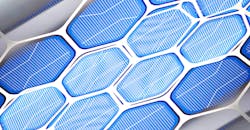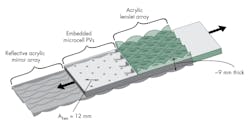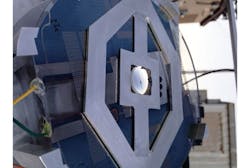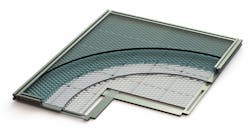“Solar cells used to be expensive, but now they’re getting cheaper,” says Chris Giebink, Charles K. Etner Assistant Professor of Electrical Engineering, Pennsylvania State University. “As a result, the solar cell is no longer the dominant cost of the energy it produces. The majority of the cost increasingly lies in everything else—the inverter, installation labor, permitting fees, etc.—all the stuff we used to neglect."
This changing economic landscape has put a premium on high efficiency. In contrast to silicon solar panels, which currently dominate the market at 15 to 20% efficiency, concentrating photovoltaics (CPVs) focus sunlight onto smaller, but much more efficient solar cells. This enables overall efficiencies of 35 to 40%. However, current CPV systems are large—the size of billboards—and have to rotate to track the sun during the day. These systems work well in open fields with abundant space and lots of direct sun.
“What we’re trying to do is create a high-efficiency CPV system in the form factor of a traditional silicon solar panel,” says Giebink. Delivering the high efficiency of traditional CPV in the form factor of a standard rooftop photovoltaic panel would be transformative.
Because it employs optics to focus sunlight onto small PV cells, the CPV must track the sun to operate efficiently. Therefore, the researchers adopted a planar translation-based approach, where optics remain fixed while PV cells slide laterally to follow the moving focal spot (Fig. 1). The tracking system uses a folded optical path where light is refracted by a top lenslet, reflected by a bottom lenslet, and then focused on an intermediate plane, which is a sheet of glass patterned with a corresponding array of solar microcells. The interfaces between this plane and those of the top and bottom lenslet arrays are lubricated by optical oil that also helps to eliminate parasitic reflections.
1. Construction of the CPV sun tracking system.
The middle solar cell sheet slides laterally to track the sun. Sunlight focused on microcells have an area of less than 1 mm2, enabling the small size and thickness of the associated lenslets and the concentrator stack. Cells are embedded in a “microtracking” panel that can accept light over a >140-deg. full field of view, allowing operation for roughly 10 hours a day. In the case of a panel based on acrylic plastic lenslet arrays, incoming sunlight is focused by a factor of more than 250, and daily average optical losses are kept below 15%.
The absolute power delivered to each of these microcells is orders of magnitude lower than that impinging on a conventional CPV cell, which is typically about 1 cm2. This simplifies thermal management because the cell can operate without the need for active cooling.
CPV Prototype
Penn State researchers reported in the July 17 issue of Nature Energy that they ran a feasibility study using a prototype CPV system that reached 30% efficiency. In outdoor testing over the course of two sunny days, the system operated automatically from sunrise to sunset, outperforming a 17%-efficient commercial silicon solar cell by generating over 54% more energy per unit area per day in a direct head-to-head competition. It could have reached 73% if microcell heating from the intense sunlight was avoided.
Developing a CPV technology involves many mechanical, electrical, optical, and manufacturing considerations. Penn State’s feasibility version employed tiny multi-junction solar cells, roughly half a millimeter square, embedded in a sheet of glass that slides between a pair of glass lenslets. The whole assembly was about 2 cm thick and tracking was done by sliding the sheet of solar cells laterally between the lenslets while the panel remains fixed at latitude tilt. Tracking for an entire day required about 1 cm of movement, which would be imperceptible in a real panel.
“Our goal in these recent experiments was to demonstrate the technical feasibility of such a system,” says Giebink. “Our prototype had a single microcell and a pair of lenses that concentrated sunlight more than 600 times, we took it outdoors and had it automatically track the sun over the course of an entire day.” (Fig. 2). These results were an important step toward the goal of producing a high-efficiency tracking CPV in the size of a standard rooftop solar panel. Figure 3 shows an artist’s conception of a future CPV the size of standard solar panel.
2. Feasibility version of the CPV employed embedded tiny multi-junction solar cells, roughly half a millimeter square, mounted on a sheet of glass that slides between a pair of plastic lenslet arrays.
3. Rendering of a future CPV the size of a typical solar panel.
Because the team needed to know exactly how much direct and diffuse sunlight there was during the test, they set up at the Russell E. Larson Agricultural Research Center at Penn State where there is a National Oceanic and Atmospheric Administration Surface Radiation monitoring site. Graduate students Jared Price and Alex Grede worked together with post-doctoral researcher Baomin Wang to test the system over two sunny days from dawn to dusk right alongside a commercial silicon solar cell.
According to Giebink, this embedded tracking CPV technology would be perfect for places with lots of direct sunlight, such as the southwestern U.S. or Australia.
Giebink notes that major challenges still lie ahead in scaling the system to larger areas and proving that it can operate reliably over the long term, but he remains optimistic.
“With the right engineering, we’re looking at a step-change in efficiency that could be useful in applications ranging from rooftops to electric vehicles—really anywhere it’s important to generate a lot of solar power from a limited area.”
Other researchers working on this research from Penn State are Jared Price and Alex Grede, graduate students in electrical engineering, and Baomin Wang, postdoctoral scholar in electrical engineering, all first authors; Michael Lipski, undergraduate student in electrical engineering; and Chris Rahn, professor, Greg Brulo, graduate student, and Xiaokun Ma, graduate student, all in mechanical engineering.
Researchers from other institutions include Brent Fisher and Scott Burroughs, Semprius Inc.; Kyu-Tae Lee and John A. Rogers, Department of Materials Science and Engineering; and Junwen He and Ralph G. Nuzzo, Department of Chemistry, all at University of Illinois at Urbana-Champaign.
The Advanced Research Projects Agency-Energy and the National Science Foundation supported this work.
About the Author

Sam Davis
Sam Davis was the editor-in-chief of Power Electronics Technology magazine and website that is now part of Electronic Design. He has 18 years experience in electronic engineering design and management, six years in public relations and 25 years as a trade press editor. He holds a BSEE from Case-Western Reserve University, and did graduate work at the same school and UCLA. Sam was the editor for PCIM, the predecessor to Power Electronics Technology, from 1984 to 2004. His engineering experience includes circuit and system design for Litton Systems, Bunker-Ramo, Rocketdyne, and Clevite Corporation.. Design tasks included analog circuits, display systems, power supplies, underwater ordnance systems, and test systems. He also served as a program manager for a Litton Systems Navy program.
Sam is the author of Computer Data Displays, a book published by Prentice-Hall in the U.S. and Japan in 1969. He is also a recipient of the Jesse Neal Award for trade press editorial excellence, and has one patent for naval ship construction that simplifies electronic system integration.
You can also check out his Power Electronics blog.



